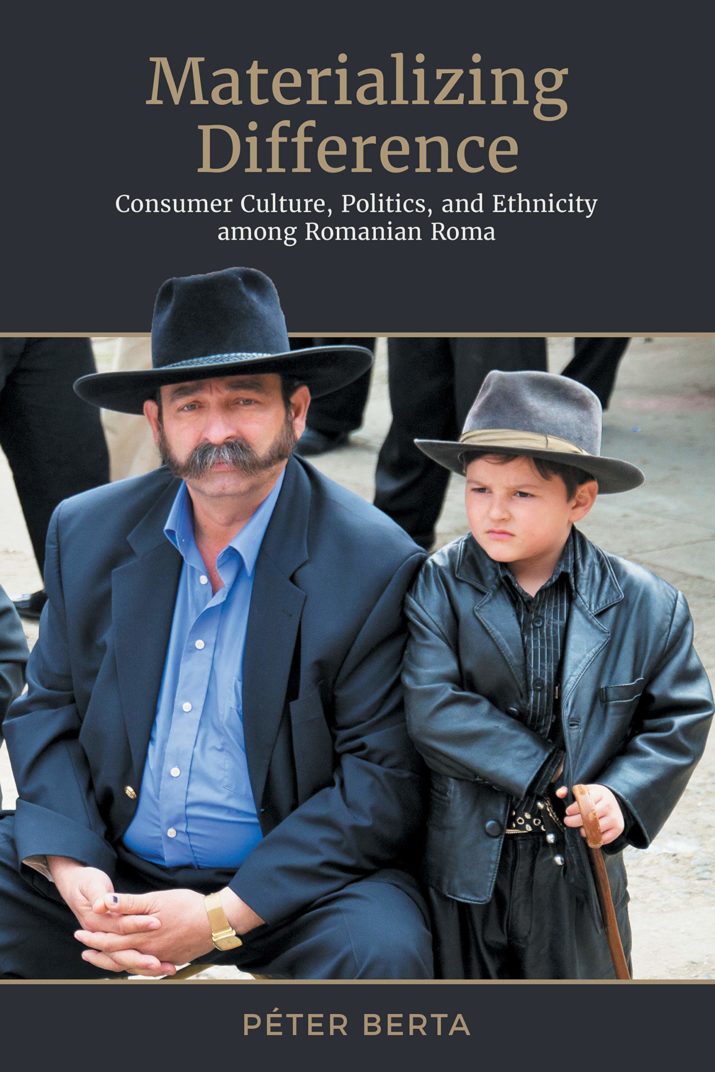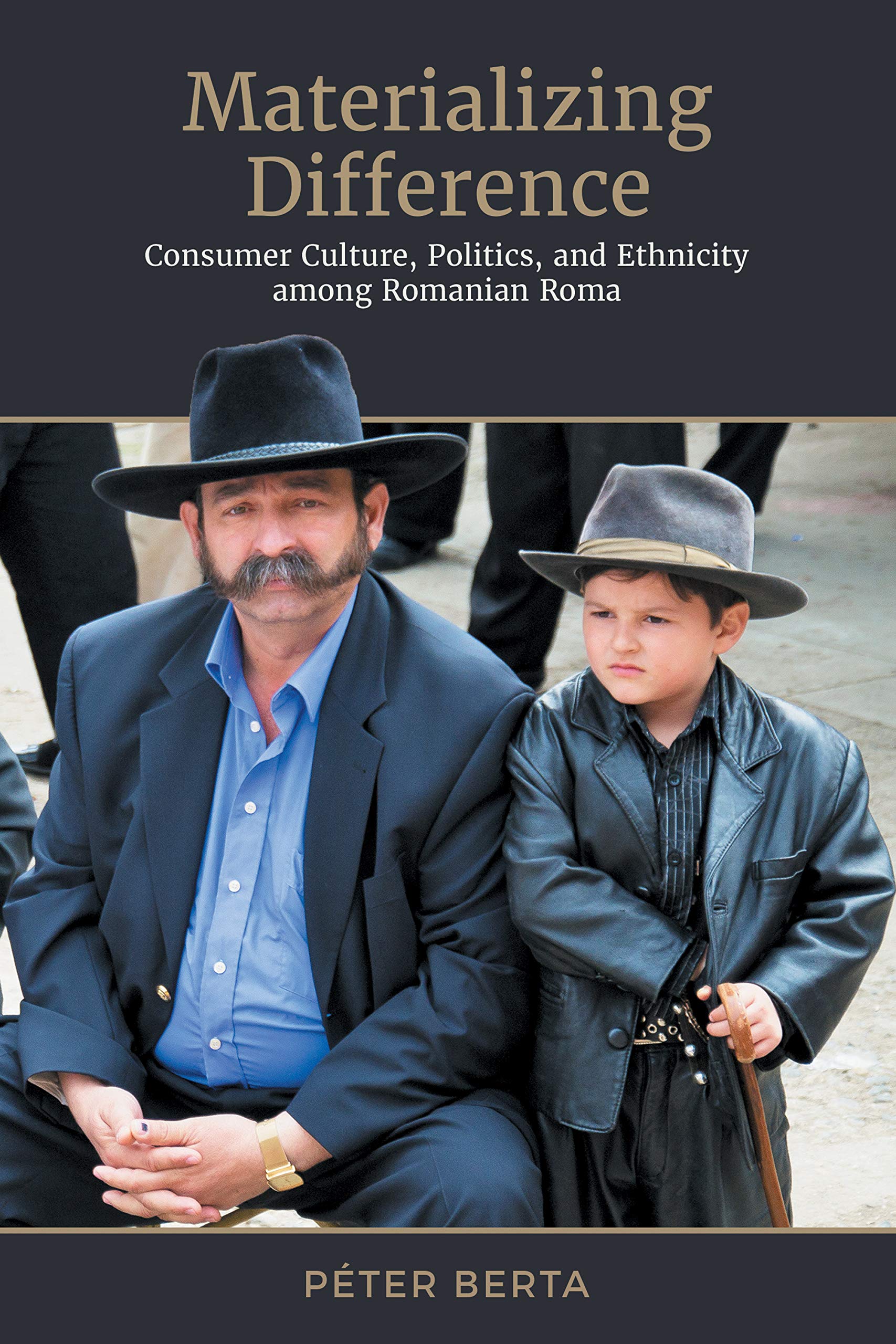
Materializing Difference: Consumer Culture, Politics, and Ethnicity among Romanian Roma by Péter Berta

More than a decade ago, Péter Berta introduced consumption and material culture studies to Romani studies (Berta 2007). In a series of articles since, he proved that analyzing Roma interactions with material objects can reveal much about contemporary Roma communities and individual lives. He has asked scholars to move beyond an exoticizing and marginalizing focus on folklore, traditional crafts, and art to questions of consumption and object circulation. Materializing Difference: Consumer Culture, Politics and Ethnicity is the first ethnographic, book-length effort to systematically explore Romani prestige economies and their related symbolic repertoires with the aim of furthering the understanding of how intra-group hierarchization relates to consumption practices within Romani communities.
Materializing Difference portrays relatively well-integrated Gabor Roma from the region of Transylvania in Romania, who enjoy a standard of living comparable to—if not higher than—that of their neighbors. Gabor Roma are proud of being Roma and are within their communities concerned with gaining attributes of social prestige. At the center of this dynamic is a specific class of prestige objects: silver beakers and roofed tankards (taxtaj and kana in Romani, respectively). For those who are not Gabor, these objects are antique silver, which was historically owned by the regional churches and gentry, but the Gabor endow them with unique histories and ethnicized meanings. Their possession increases renown of individuals, of families, and of local communities.
Materializing Difference is a story of socialism and post-socialism. It not only describes how this specific class of objects relates to other forms of wealth and luxury that people value, but it places this ethnicized segment of informal economy in the context of socialist property relations. These relations have been re-shaped by post-socialist transformations, including the emergence of transnational trade, migration, and the expansion of financialized credit economy. For this reason alone, this is a welcome publication and should be read by scholars beyond Romani studies, such as those interested in consumption and notions of value in contemporary Europe. It provides a case study of a unique prestige economy and reveals the creativity through which Roma forge their place among the non-Roma in Eastern Europe.
The central aporia of the book is this: Gabor face-work depends on managing a tension between what Berta calls “ethics of sociability” and “the politics of difference.” Gabor men compete with one another for fame or social prestige within their communities, which is talked about as “Roma politics” and is intimately connected with political discourse at social gatherings where Roma men use songs, speeches, or other social interactions to establish hierarchies among themselves. One’s status depends on acquiring attributes that correspond with Gabor ideology of hierarchy, such as economic success, kinship belonging, or marital alliances. All of these are materialized in ownership and the circulation of beakers and tankards.
Ultimately though, demonstrating one’s worth and receiving recognition from others depends on gaining respectability—that is, on showing restraint and respect towards others. This means that even when a man wants to talk about the beaker he owns and suggest that it is worth more than those of other men present—something Gabor typically are keen to do—he cannot do so directly without showing disrespect to others and losing respectability in turn. But there are ways to highlight worth and maintain respect. One is to sing Hungarian-language songs about horses, carts, and cavaliers. Gabor men find these songs attractive, because, by alluding to their own taxtajs and kanas as horses, they can speak about successes in the prestige economy vaguely and thus save face of the audience. Concerns with reputation impacts how beakers and tankards circulate. Although they are ideally inalienable and should remain in the patriline, when facing unmanageable debt, for instance, a Gabor man might be forced to part with them. As selling these objects to other Gabor can hurt his prestige, he may sell or pawn them to a Cărhar Roma man. For Cărhar Roma, who have also developed a prestige economy in the past one hundred and fifty years or so, these objects are the most expensive luxury that serve as “political trophies.”
Since anthropological monographs on Roma communities typically focus on one community at a time, devoting almost a third of the book to Cărhar Roma and on economic interactions between two Roma groups is in itself original. Unfortunately, when discussing aspects of Cărhar sociality to which prestige objects are central, such as inheritance and marriage, Berta does so without referencing other authors who have explored the same issues (e.g. Tesǎr 2013). In fact, here lies my main issue with Materializing Difference: although the book engages with classical works in material culture and consumption studies, it largely ignores Romani-related research in anthropology. Most problematically, when discussing the Gabor sense of their own nobility or notions of respectability (patjiv), Berta does not engage with the work of Martin Olivera (e.g. 2012), who offers a different theoretical perspective. It is also a misrepresentation of the scholarship to state that the “majority of analyses [of Roma inter-ethnic relations] have focused mainly on the ideologies of equality-centrism” (12). Paloma Gay y Blasco’s (1999) ethnography, which Berta lists as one example of this tendency, is precisely about how hierarchy and inequality among Spanish Gitano men emerge in a context where autonomy, honor and moral similarity are valued—the paradox that Berta is concerned with.
In what is probably the best moment of the book, Berta shows why Gabor men compete to buy such beakers and tankards: an owner not only becomes a part of his object’s inalienable ownership history and its fame, but his renown among Gabor grows thanks to his acquired status as the object’s owner. To be sure, it is clear why Berta chose to foreground the politics of difference, which is materialized in the prestige economy: this is how Gabor talk when they present their successes. At the same time, if the ideology of hierarchy and the politics of difference lie at the core of Gabor sociality, why does “participation in politics” remain “only an optional practice” and non-involvement “is not accompanied by major negative symbolic consequences” (46)? How does Berta’s claim that “respecting ethics of sociability”—associated with sharing and cooperative behavior— is “expected of every individual” (46) square with his identification of the dynamics of differentiation as central? Indeed, while reading Materializing Difference, I repeatedly wondered how many Gabor actually participate in the prestige economy. The reader never receives a satisfying answer and only towards the end does one learn that its popularity is declining.
Berta’s broader perspective emerges as the product of his attempt to follow objects across different consumer subcultures. The real value of this “things in motion” approach comes to relief when he centers the social biographies of a beaker and a tankard. The case studies bring to life processes through which prestige objects gain meaning and increase their owner’s fame. For instance, Berta describes how a purchase of an important object required a buyer to assess carefully whom to invite to join him in negotiations, causing conflict with his in-laws. In addition to ethnographic value of these two case studies, they become revealing of how changes in consumer behavior contribute to the lack of interest among younger generations in beakers and tankards, and how the impact the economic transformation had motivated a more straightforward buying and selling of prestige objects among Gabor.
A persistent issue with anthropology of Romanies is the failure to grasp that material objects are also actors in their own right—they produce particular effects and enable certain practices while limiting others (but see e.g. Racles 2018). Materializing Difference, which focuses on meaning, does little to address this issue. Tankards and beakers are not treated as participants, in, for instance, hybridizing and assembling Gabor history—something that Berta insists is one of their main accomplishments. Rather, they are treated as distinct pre-existing entities—sums of their parts (patina, history, size, etc.)—that the analyst from his privileged vantage point enumerates and weighs. Here is a missed opportunity to think about these objects in a new way, as assemblages or performances, which aggregate heterogeneous relations that are both external and internal to them. Berta also misses an opportunity to explore beakers and tankards as “events” and to take the analysis of materiality and consumption to another level. No effort is made to understand how through objects and controversies surrounding their meaning and valuation, specific prestige objects and Gabor social persons are brought into being simultaneously.
Berta shows convincingly that beakers and tankards, which once belonged to the non-Roma, have been refashioned by Gabor into an independent tool of sociality. But they are not only symbols. Through these objects, their materiality and circulation, Gabor (and Cărhar) Roma have found a mode through which people on the margins of the state can not only preserve value from state appropriation but attain, in a way that is historically embedded locally, a measure of sovereignty of social life.
Martin Fotta is a post-doctoral research fellow in the Department of Social and Cultural Anthropology at the Goethe University Frankfurt. He is the author of From Itinerant Trade to Moneylending in the Era of Financial Inclusion: Households, Debts and Masculinity among Calon Gypsies of Northeast Brazil (2018). His research has appeared in the Journal of the Royal Anthropological Institute, Social Analysis, and the Journal of Latin American Cultural Studies.
Materializing Difference: Consumer Culture, Politics, and Ethnicity among Romanian Roma
By Péter Berta
Publisher: University of Toronto Press
Paperback / 390 pages / 2019
ISBN: 9781487520403
References
Berta, P. (2007). Ethnicisation of value–the value of ethnicity: The prestige-item economy as a performance of ethnic identity among the Gabors of Transylvania (Rumania). Romani Studies, 17(1), 31-65.
Gay y Blasco, P. (1999). Gypsies in Madrid: Sex, gender and the performance of identity. Oxford; New York: Berg.
Olivera, M. (2012). La tradition de l’intégration: une ethnologie des Roms Gabori dans les années 2000. Paris: Editions Pétra.
Racles, A. (2018) “Walking with Lina in Zamora. Reflections on Roma’s home-making engagements from a translocality perspective.” Intersections. East European Journal of Society and Politics 4(2): 86-108.
Tesǎr, C. (2013). ‘Women married off to chalices’: gender, kinship and wealth among Romanian Cortorari gypsies (Doctoral dissertation, University College London).
Published on April 28, 2020.




